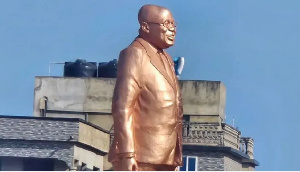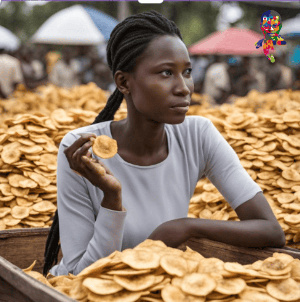BBC Pidgin of Sunday, 11 December 2022
Source: BBC
Base editing: Revolutionary therapy clear girl from cancer wey no get cure
One teenage girl cancer wey bin no get cure before don clear from her body for di first use of one revolutionary new type of medicine.
All oda treatments for Alyssa leukaemia bin fail.
So doctors for Great Ormond Street Hospital use "base editing" to perform wetin eye neva see before wit biological engineering to build her one new living drug.
Six months later di cancer don clear, but dem still dey monitor Alyssa is still being monitored in case e come back.
Alyssa, wey dey 13 years come and from Leicester, bin get T-cell acute lymphoblastic leukaemia for May last year.
T-cells suppose dey guard di body - dey search for and destroy anytin wey dey threaten di body - but for Alyssa dem don become di danger and dem bin dey grow out of control.
Her cancer bin dey aggressive. Chemotherapy, and then bone-marrow transplant, bin no fit remove am from her body.
Without di experimental medicine, di only option wey dey na to make Alyssa as comfortable as possible.
"Eventually I for die," Alyssa tok. Her mama, Kiona, say dis time last year she bin dey fear Christmas, "thinking say dis go be our last wit her". And den she "just cry" throughout her daughter 13 year birthday for January.
- To cari belle immediately afta miscarriage no dey risky - Experts tok
- Di treatment wey dey change di life of teenagers wit clubfoot
- Baby wey dem give one day to live, celebrate 1 year birthday
Wetin happun next no be wetin we for bin dey tink just few years ago and dey possible now sake of di progress for genetics.
Di team for Great Ormond Street use one technology wey dem dey call 'base editing', wey dem invent only six years ago.
Bases an language of life. Di four types of base - adenine (A), cytosine (C), guanine (G) and thymine (T) - na di building blocks of our genetic code.
Just as letters for alphabet dey spell words wey carry meaning, di billions of bases for our DNA dey spell di instruction manual for our body.
Base editing allow scientists to zoom to di exact part of di genetic code and den alter di molecular structure of just one base, convert am into anoda and change di genetic instructions.
Di large team of doctors and scientists use dis tool to engineer new type of T-cell wey fit to hunt down and kill Alyssa cancerous T-cells.
Dem bin start wit healthy T-cells wey come from one donor and dem come modify dem.
- Di first base edit disable di T-cells targeting mechanism so dem no go fit assault Alyssa body
- Di second remove chemical marking, wey dem call CD7, wey dey on all T-cells
- Di number three edit na invisibility cloak wey dey prevent di chemotherapy drug from killing di cells
- Di final stage of genetic modification instruct di T-cells to go hunting for anytin wey get CD7 marking am so dat e go destroy every T-cell for her body - including di cancerous ones.
Dat na why dem gatz remove dis marking has to be removed from di therapy - othervise e go just destroy imsef.
If di therapy work, Alyssa immune system - including T-cells - go rebuild wit di second bone-marrow transplant.
Wen dem explain di idea to di the family, her mama bin dey tink: "You fit do dat?" Na Alyssa decision to be di first to take di experimental therapy - wey contain millions of modified cells - for May dis year.
"She be di first patient wey we dey treat wit dis technology," Prof Waseem Qasim, from UCL and Great Ormond Street, tok.
Im say dis genetic manipulation na "very fast-moving area of science" wit "massive potential" for different kain of diseases.
Alyssa bin dey vulnerable to infection, as di designer cells attack both di cancerous T-cells for her body plus di ones wey dey protect her from disease.
After one month, Alyssa dey in remission and dem give her second bone-marrow transplant to regrow her immune system.
Alyssa spend 16 weeks for hospital and bin no fit see her brother, wey still dey go school, in case im carry germs come.
Di doctors bin worry wen dem find signs of cancer again afta di three-month check-up. But her two most recent investigations dey clear.
"You just learn to appreciate every little tin. I just dey so grateful say I dey here now," Alyssa say.
"E dey crazy. E just dey amazing say I bin fit get dis opportunity, I dey very thankful for am and e go help oda pikin dem too for future."
She dey eye Christmas, as par she go be one of di bridesmaid for her aunty wedding, ride her bike again, go back to school and "just do tin wey normal pipo dey do".
Di family hope say di cancer no go ever come back, but dem already dey grateful for di time wey e buy dem.
"To have dis extra year, dis last three months wen she bin dey home na git on im own," Kiona tok.
James, her papa, say: "I find am quite hard to talk about how proud we dey. Wen you see wetin she go through and her vitality of life wey she bring every situation, d dey outstanding."
Most children wit leukaemia respond to di main treatments, but di thinking be say about 12 children fit benefit from dis therapy each year.
Alyssa na just di first of 10 pipo wey dem don give dis medicine as part of one clinical trial.
Dr Robert Chiesa, from di bone-marrow transplant department for Great Ormond Street Hospital, say: "E dey extremely exciting. Obviously, dis na new field for medicine and e dey mesmerising say we fit redirect di immune system to fight cancer."
Di technology sha only scratch di surface of wetin base editing fit achieve.
Dr David Liu, one of di inventors of base editing for di Broad Institute, tell me say e dey "a bit strange" say dem bin dey treat pipo just six years aft dem invent technology.
For Alyssa therapy, each of di base edit involve breaking one section of genetic code so e no go work again. But e get some applications wia instead of switching instruction off you fit fix di one wey spoil. Sickle-cell anaemia, for example, na just one base change dey cause and e fit dey corrected.
So e already get some editing for sickle-cell disease, as well as high cholesterol wey dey run for families and di blood disorder beta-thalassemia.
Dr Liu say di "therapeutic applications of base editing just dey begin" and e dey "humbling to be part of dis era of therapeutic human gene editing", as science dey now take "key steps towards taking control of our genomes".
Entertainment













